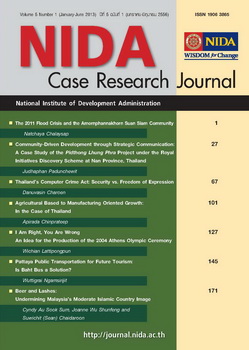Community-Driven Development through Strategic Communication: A Case Study of the Pidthong Lhung Phra Project under the Royal Initiatives Discovery Scheme at Nan Province, Thailand
Abstract
In early 2012, Khun Tanakorn Rachtanonda, the 54-year-old Manager of the Pidthong Lung Phra Project (PLPP) at Nan Province, one of the projects under the Royal Initiatives Discovery Scheme (RID) in Thailand, shared with a university researcher his experiences in rural and community development, focusing specially on the Nan Pilot Project for which he had assumed managerial responsibility in mid July, 2010. Khun Tanakorn, who was also Vice Chairman of the Working Committee of the RID at Nan, had come to join the Nan project after an earlier two years of experiences in rural and community development at the widely acclaimed Doi Tung Team of Rural Development in Chiang Rai province. As he reminisced about what was uppermost in his mind when he arrived at the Nan project site, he recalled having been concerned about how to design effective programs with the concept of community-driven development (CDD), emphasizing the giving of control of decisions and resources to community groups as the core practices. In particular, he had been keen to make maximum use of strategic communication to facilitate the acquisition of capacity building, service delivery, and social mobilization as guided by the King’s model of Philosophy of Sufficiency Economy.
When he had been assigned to design, operate, and manage the RID scheme at Nan, he had been charged with making Nan as successful as the projects at Doi Tung – the Development Project (DTDP) that had been launched two decades earlier by the Mae Fah Luang Foundation (MFLF)[1]. With Doi Tung’s Model of the Mae Fah Luang Social Transformation as the template for community development in mind, Khun Tanakorn was fully committed to an integrated and holistic approach to the Sustainable Alternative Livelihood Development (SALD), which aimed first to rejuvenate nature, empower the individual, and strengthen the community. To its core, the DTDP specifically promoted the four values of human wisdom, social well-being, environmental fairness, and economic prosperity. At the time that he had been placed in charge of the Nan projects, it had been explained to Khun Tanakorn that he had 12 years to make the projects work and to scale them up, after which he and parts of his team would be expected to move on to other provinces and teach the CDD approach to rural and community development. With that in mind, he had resolved the make the Nan scheme a glowing success.




